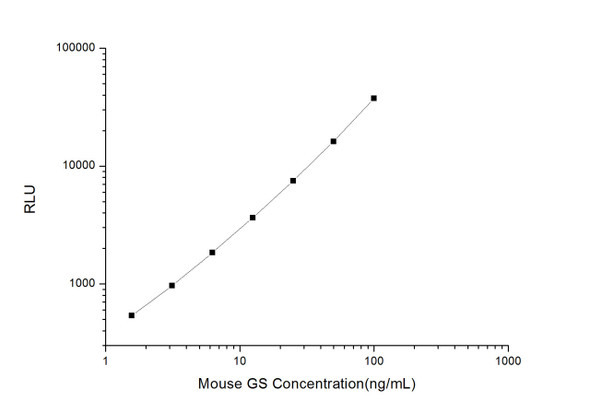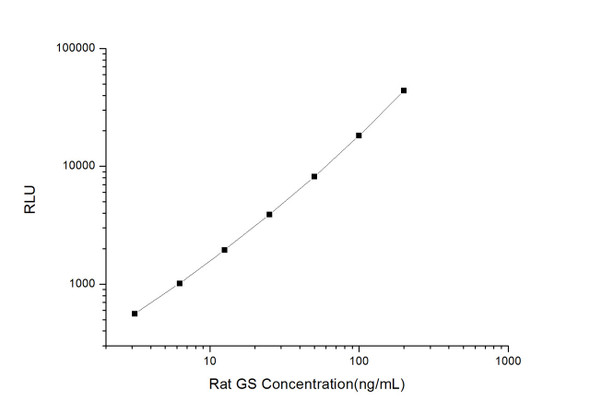Human Cell Biology ELISA Kits 5
Human GS (Gelsolin) CLIA Kit (HUES00993)
- SKU:
- HUES00993
- Product Type:
- ELISA Kit
- ELISA Type:
- CLIA Kit
- Size:
- 96 Assays
- Sensitivity:
- 0.75ng/mL
- Range:
- 1.25-80ng/mL
- ELISA Type:
- Sandwich
- Synonyms:
- GSN, ADF, AGEL
- Reactivity:
- Human
- Sample Type:
- Serum, plasma and other biological fluids
- Research Area:
- Cell Biology
Description
| Assay type: | Sandwich |
| Format: | 96T |
| Assay time: | 4.5h |
| Reactivity: | Human |
| Detection method: | Chemiluminescence |
| Detection range: | 1.25-80 ng/mL |
| Sensitivity: | 0.75 ng/mL |
| Sample volume: | 100µL |
| Sample type: | Serum, plasma and other biological fluids |
| Repeatability: | CV < 15% |
| Specificity: | This kit recognizes Human GS in samples. No significant cross-reactivity or interference between Human GS and analogues was observed. |
This kit uses Sandwich-CLIA as the method. The micro CLIA plate provided in this kit has been pre-coated with an antibody specific to Human GS. Standards or samples are added to the appropriate micro CLIA plate wells and combined with the specific antibody. Then a biotinylated detection antibody specific for Human GS and Avidin-Horseradish Peroxidase (HRP) conjugate are added to each micro plate well successively and incubated. Free components are washed away. The substrate solution is added to each well. Only those wells that contain Human GS, biotinylated detection antibody and Avidin-HRP conjugate will appear fluorescence. The Relative light unit (RLU) value is measured spectrophotometrically by the Chemiluminescence immunoassay analyzer. The RLU value is positively associated with the concentration of Human GS. The concentration of Human GS in the samples can be calculated by comparing the RLU of the samples to the standard curve.
| UniProt Protein Function: | Gelsolin: a calcium-regulated, actin-modulating protein that binds to the plus (or barbed) ends of actin monomers or filaments, preventing monomer exchange (end-blocking or capping). It can promote the assembly of monomers into filaments (nucleation) as well as sever filaments already formed. Its expression is significantly decreased in many tumors and transformed cell lines. Gelsolin and other proteins including E-cadherin, BRCA, p21WAF, HoxA5, and retinoic acid receptor II are regulated by epigenetic changes in breast cancers. Gelsolin helps mediate the ability of HDAC inhibitors to protect neurons from oxygen/glucose deprivation. Two human isoforms are produced by alternative initiation. |
| UniProt Protein Details: | Protein type:Nuclear receptor co-regulator; Secreted, signal peptide; Secreted; Motility/polarity/chemotaxis; Actin-binding Chromosomal Location of Human Ortholog: 9q33 Cellular Component: ruffle; focal adhesion; protein complex; perinuclear region of cytoplasm; lamellipodium; extracellular region; cytosol; actin cytoskeleton Molecular Function:protein binding; calcium ion binding; actin binding Biological Process: regulation of cell adhesion; actin filament severing; phosphoinositide-mediated signaling; apoptosis; actin nucleation; vesicle-mediated transport; response to ethanol; actin filament polymerization; tissue regeneration; response to folic acid; oligodendrocyte development; barbed-end actin filament capping; cell structure disassembly during apoptosis; aging Disease: Amyloidosis, Finnish Type |
| NCBI Summary: | The protein encoded by this gene binds to the "plus" ends of actin monomers and filaments to prevent monomer exchange. The encoded calcium-regulated protein functions in both assembly and disassembly of actin filaments. Defects in this gene are a cause of familial amyloidosis Finnish type (FAF). Multiple transcript variants encoding several different isoforms have been found for this gene. [provided by RefSeq, Jul 2008] |
| UniProt Code: | P06396 |
| NCBI GenInfo Identifier: | 121116 |
| NCBI Gene ID: | 2934 |
| NCBI Accession: | P06396. 1 |
| UniProt Secondary Accession: | P06396,Q5T0I2, Q8WVV7, A2A418, A8MUD1, A8MYN7, B7Z373 B7Z5V1, F5H1A8, |
| UniProt Related Accession: | P06396 |
| Molecular Weight: | 782 |
| NCBI Full Name: | Gelsolin |
| NCBI Synonym Full Names: | gelsolin |
| NCBI Official Symbol: | GSN |
| NCBI Official Synonym Symbols: | ADF; AGEL |
| NCBI Protein Information: | gelsolin; brevin; actin-depolymerizing factor |
| UniProt Protein Name: | Gelsolin |
| UniProt Synonym Protein Names: | AGEL; Actin-depolymerizing factor; ADF; Brevin |
| Protein Family: | Gelsolin |
| UniProt Gene Name: | GSN |
| UniProt Entry Name: | GELS_HUMAN |
As the RLU values of the standard curve may vary according to the conditions of the actual assay performance (e. g. operator, pipetting technique, washing technique or temperature effects), the operator should establish a standard curve for each test. Typical standard curve and data is provided below for reference only.
| Concentration (ng/mL) | RLU | Average | Corrected |
| 80 | 36603 38311 | 37457 | 37428 |
| 40 | 14979 17259 | 16119 | 16090 |
| 20 | 7568 7332 | 7450 | 7421 |
| 10 | 3299 3933 | 3616 | 3587 |
| 5 | 1851 1797 | 1824 | 1795 |
| 2.5 | 1021 897 | 959 | 930 |
| 1.25 | 523 547 | 535 | 506 |
| 0 | 28 30 | 29 | -- |
Precision
Intra-assay Precision (Precision within an assay): 3 samples with low, mid range and high level Human GS were tested 20 times on one plate, respectively.
Inter-assay Precision (Precision between assays): 3 samples with low, mid range and high level Human GS were tested on 3 different plates, 20 replicates in each plate.
| Intra-assay Precision | Inter-assay Precision | |||||
| Sample | 1 | 2 | 3 | 1 | 2 | 3 |
| n | 20 | 20 | 20 | 20 | 20 | 20 |
| Mean (ng/mL) | 4.10 | 11.97 | 32.19 | 4.09 | 12.54 | 30.78 |
| Standard deviation | 0.42 | 1.10 | 3.47 | 0.37 | 1.01 | 2.63 |
| C V (%) | 10.24 | 9.19 | 10.78 | 9.05 | 8.05 | 8.54 |
Recovery
The recovery of Human GS spiked at three different levels in samples throughout the range of the assay was evaluated in various matrices.
| Sample Type | Range (%) | Average Recovery (%) |
| Serum (n=5) | 90-103 | 96 |
| EDTA plasma (n=5) | 100-113 | 106 |
| Cell culture media (n=5) | 86-100 | 92 |
Linearity
Samples were spiked with high concentrations of Human GS and diluted with Reference Standard & Sample Diluent to produce samples with values within the range of the assay.
| Serum (n=5) | EDTA plasma (n=5) | Cell culture media (n=5) | ||
| 1:2 | Range (%) | 95-109 | 86-100 | 88-104 |
| Average (%) | 102 | 93 | 95 | |
| 1:4 | Range (%) | 85-99 | 88-100 | 101-115 |
| Average (%) | 91 | 93 | 107 | |
| 1:8 | Range (%) | 97-113 | 83-97 | 96-109 |
| Average (%) | 104 | 90 | 102 | |
| 1:16 | Range (%) | 95-108 | 96-110 | 91-107 |
| Average (%) | 101 | 103 | 98 |
An unopened kit can be stored at 4°C for 1 month. If the kit is not used within 1 month, store the items separately according to the following conditions once the kit is received.
| Item | Specifications | Storage |
| Micro CLIA Plate(Dismountable) | 8 wells ×12 strips | -20°C, 6 months |
| Reference Standard | 2 vials | |
| Concentrated Biotinylated Detection Ab (100×) | 1 vial, 120 µL | |
| Concentrated HRP Conjugate (100×) | 1 vial, 120 µL | -20°C(shading light), 6 months |
| Reference Standard & Sample Diluent | 1 vial, 20 mL | 4°C, 6 months |
| Biotinylated Detection Ab Diluent | 1 vial, 14 mL | |
| HRP Conjugate Diluent | 1 vial, 14 mL | |
| Concentrated Wash Buffer (25×) | 1 vial, 30 mL | |
| Substrate Reagent A | 1 vial, 5 mL | 4°C (shading light) |
| Substrate Reagent B | 1 vial, 5 mL | 4°C (shading light) |
| Plate Sealer | 5 pieces | |
| Product Description | 1 copy | |
| Certificate of Analysis | 1 copy |
- Set standard, test sample and control (zero) wells on the pre-coated plate and record theirpositions. It is recommended to measure each standard and sample in duplicate. Note: addall solutions to the bottom of the plate wells while avoiding contact with the well walls. Ensuresolutions do not foam when adding to the wells.
- Aliquot 100 µL of standard solutions into the standard wells.
- Add 100 µL of Sample / Standard dilution buffer into the control (zero) well.
- Add 100 µL of properly diluted sample (serum, plasma, tissue homogenates and otherbiological fluids. ) into test sample wells.
- Cover the plate with the sealer provided in the kit and incubate for 90 min at 37 °C.
- Aspirate the liquid from each well, do not wash. Immediately add 100 µL of BiotinylatedDetection Ab working solution to each well. Cover the plate with a plate seal and gently mix. Incubate for 1 hour at 37 °C.
- Aspirate or decant the solution from the plate and add 350 µL of wash buffer to each welland incubate for 1-2 minutes at room temperature. Aspirate the solution from each well andclap the plate on absorbent filter paper to dry. Repeat this process 3 times. Note: a microplatewasher can be used in this step and other wash steps.
- Add 100 µL of HRP Conjugate working solution to each well. Cover with a plate seal andincubate for 30 min at 37 °C.
- Aspirate or decant the solution from each well. Repeat the wash process for five times asconducted in step 7.
- Add 100 µL of Substrate mixture solution to each well. Cover with a new plate seal andincubate for no more than 5 min at 37 °C. Protect the plate from light.
- Determine the RLU value of each well immediately.



